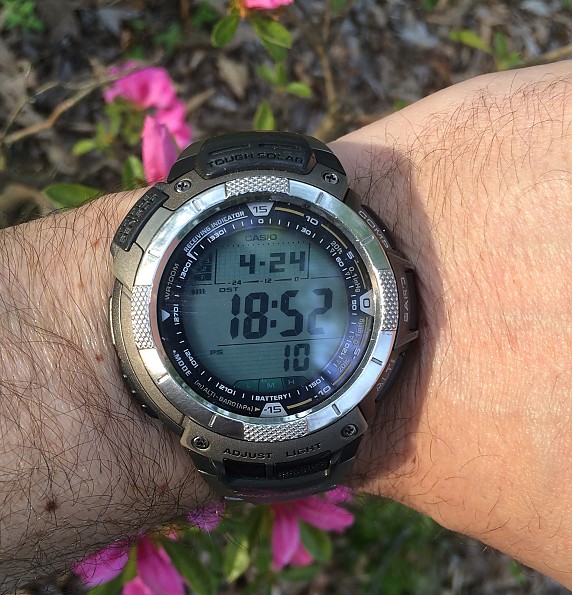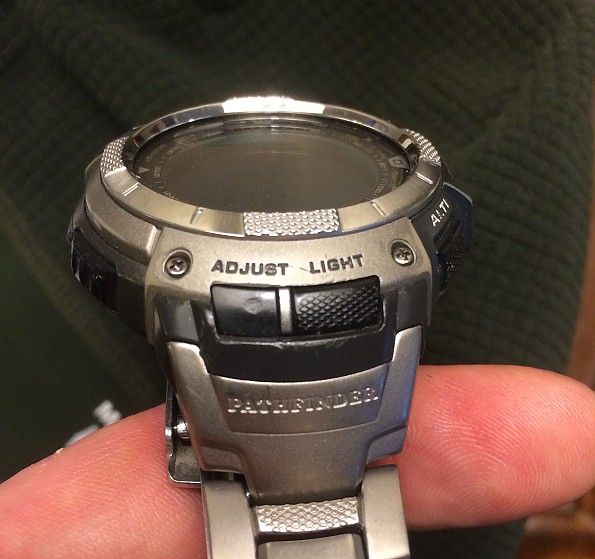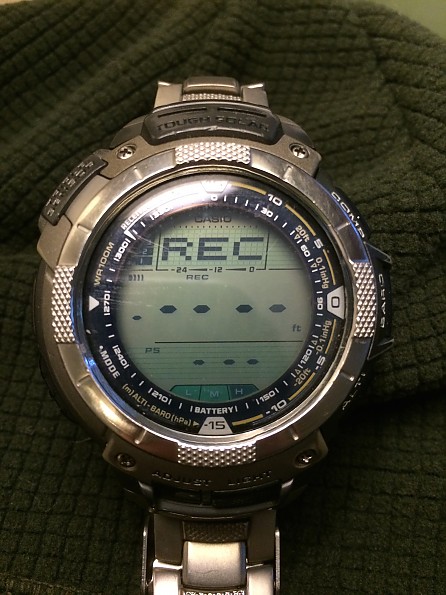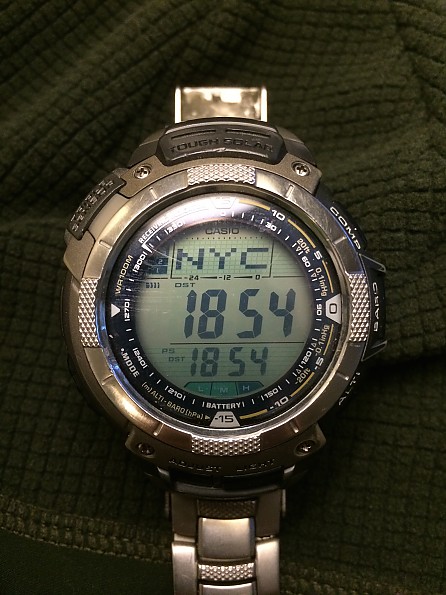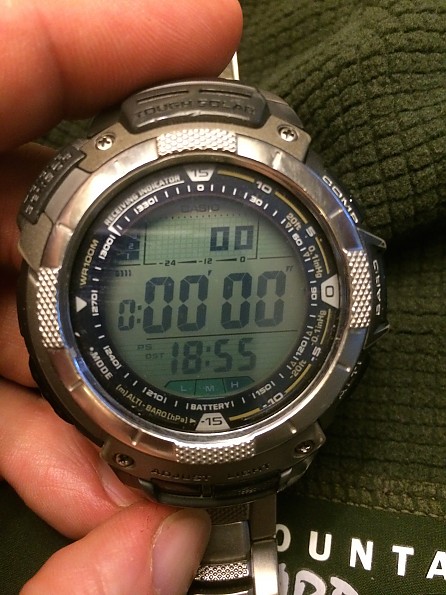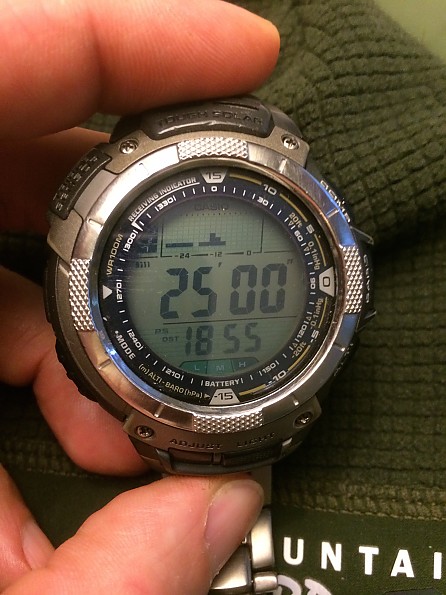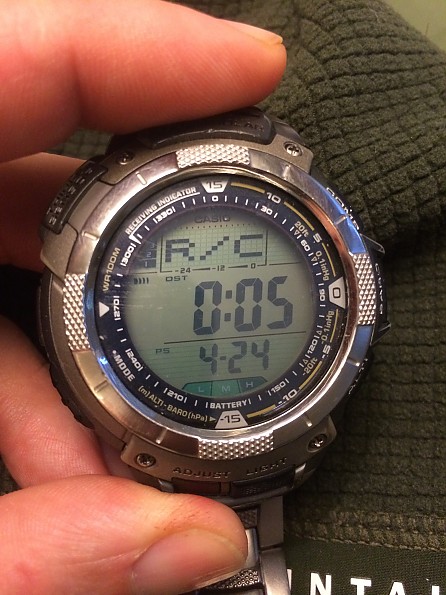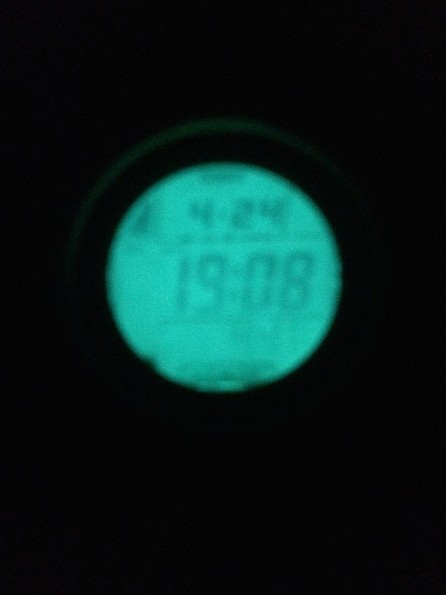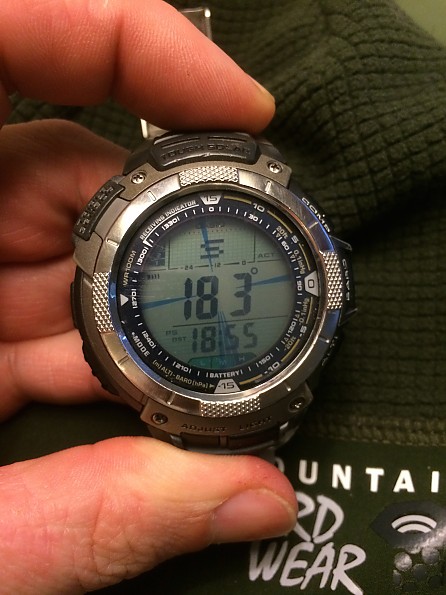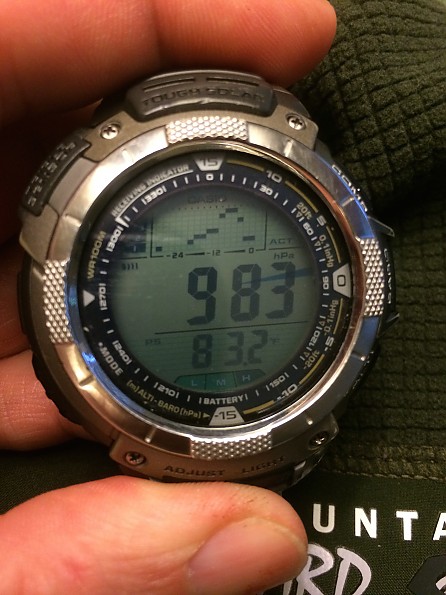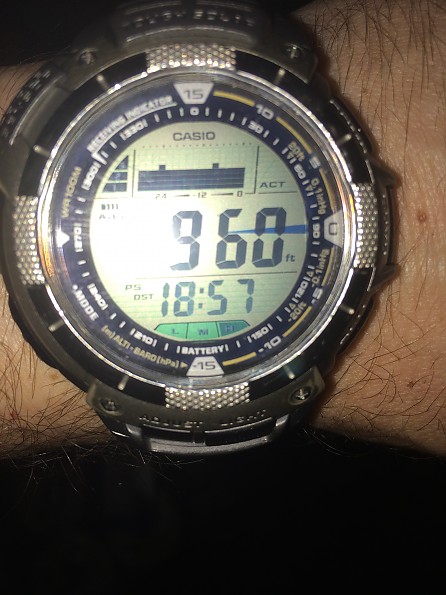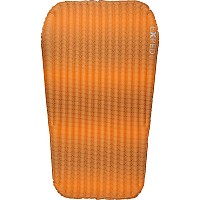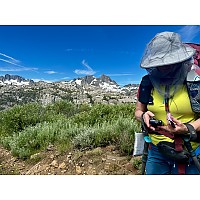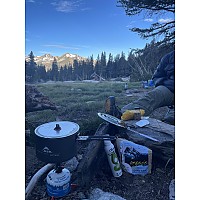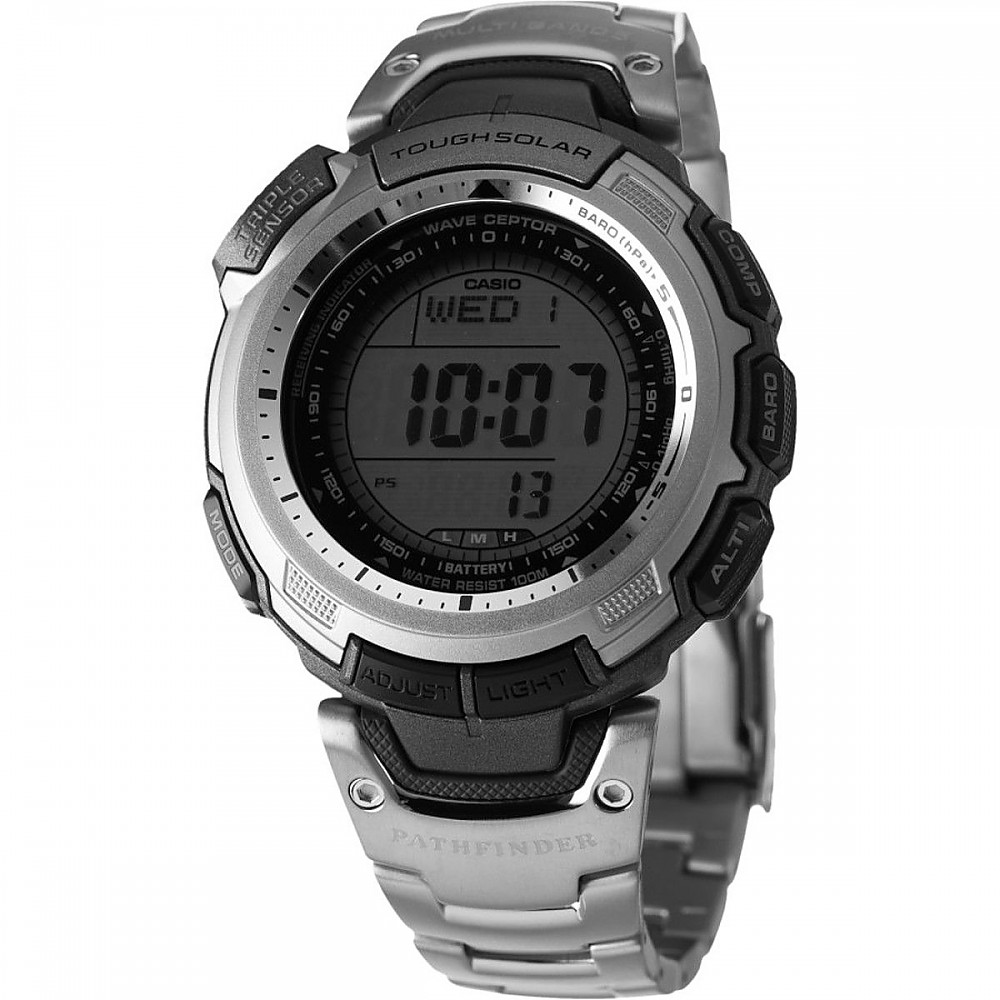
Solar-powered altimeter, barometer and compass (ABC) watch with radio time calibration, temperature sensor, world time, stopwatch, and timer.
Pros
- Solar-powered—no need to recharge or change battery
- Basic ABC functions accessible with a single button-press
- Keeps accurate time with radio time calibration (if within range of transmitting stations)
- Other functions including world time, stopwatch, timer, alarms etc
- Glass is recessed below the bezel for protection
Cons
- Interface not user-friendly: this limits use of advanced ABC functions
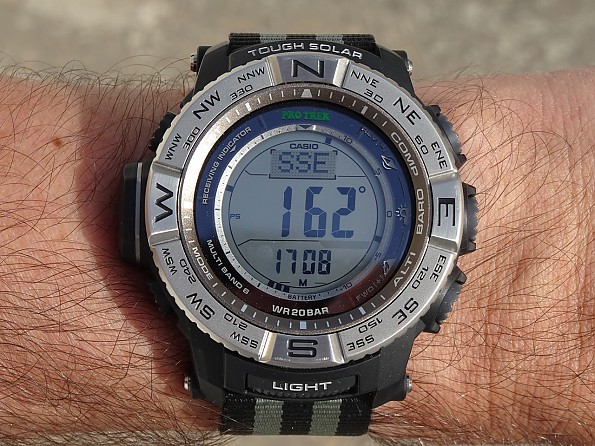
The Casio PRW3500 is one of the older models in Casio’s Pro Trek series of hiking watches (previously known as the Pathfinder series). I believe it has been discontinued, but it is still available for sale.
This watch looks basic. It has no fancy graphics, just a digital display reminiscent of the 1980s. It is an altimeter–barometer–compass (ABC) watch with a temperature sensor and world time. It has various other functions, but it cannot connect to your smartphone, play music, count your steps, measure your heartbeat rate, or display your position on a map. If you want these features, this watch is not for you.
This watch is for you if you want a rugged ABC watch that does not need recharging. Being digital, it has few moving parts that can potentially break down. It is solar-powered and it has a huge power reserve since it does not need to drive moving hands or light up an all-colour screen. According to the official specs a full charge is enough for seven months of normal use or 23 months in storage with power-saving on. I cannot verify these figures, but I have owned another Casio solar ABC watch (a PRG270) for more than four years and in all this time it has never run low on power.
The downside of the PRW3500 is its user interface, which also feels straight out of the 1980s. Most of its advanced features are accessed through a non-intuitive sequence of button-presses that must be memorised. This makes the features hard to use. However, I knew this when I bought the watch because my PRG270 has a similar interface. I do not plan to make much use of the watch's advanced features because I have a handheld GPS unit that supplies me with much of the information I need on hiking expeditions.
The watch offers me a degree of device redundancy. My use of its ABC functions will normally be limited to those I can access with a single button-press (especially the compass) as an alternative to digging into the menu of my GPS. I have used the PRG270 in this way. It came into its own during a walking expedition in Wales last year, when I was crossing a stretch of boggy terrain with no clear path and no landmarks in filthy weather, and I used the watch to stay oriented in the right direction.
The PRW3500 is of similar vintage to the PRG270, which I have already reviewed on Trailspace. In addition to sharing the same user interface, both models use Casio’s Version 3 triple sensor. Everything about charging, features and the user interface in the PRG270 review also applies to the PRW3500, so it is worth reading both reviews together. This review will concentrate on the unique points of the PRW3500.
The first thing I did when I received my PRW3500 was to remove the resin watch band and replace it with a one-piece nylon “NATO” strap. The resin band is by no means uncomfortable, but if you have skinny wrists like me you will be left with a lot of extra length to catch on your sleeve and irritate you. With a nylon strap you can tuck the extra length inside the metal retainers.
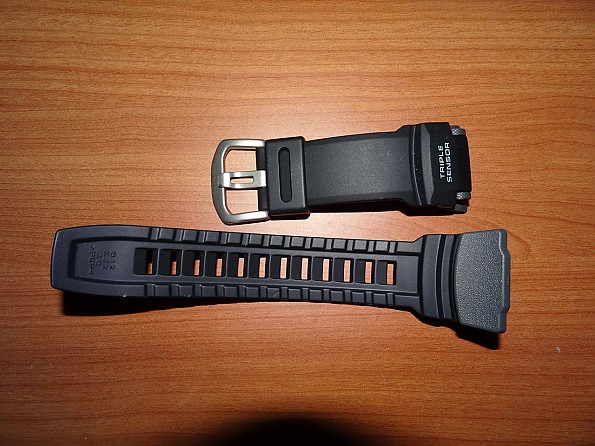
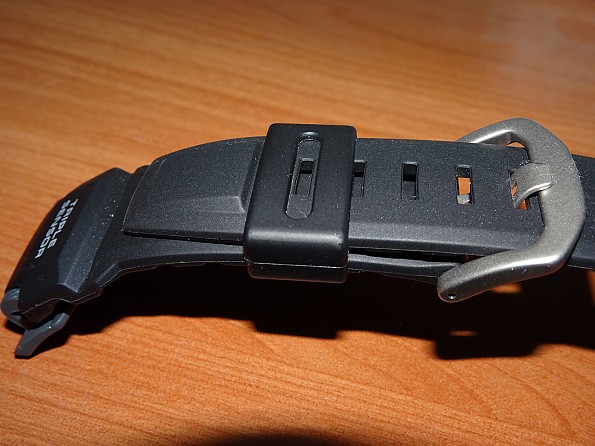
Removing the resin band is relatively easy thanks to the screws on the watch lugs. 22-millimetre nylon straps make a perfect fit as long as they are not the heavy-duty type, which is too thick to pass through the gap between the pins and the watch body. Heavy-duty straps are overkill, however. Thinner straps are still tough and I have never had one fail on me.
The PRW3500 measures 56.9 × 53.4 × 14.5 mm, which makes it a big watch—even bigger than the PRG270, which is 54.6 × 52.4 × 14.4 mm. However, the PRW3500 does not look as massive as these measurements would suggest. The watch face is dominated by its rotating bezel or ring, which is only 46 mm in diameter. As a result the watch does not overwhelm my wrist, although its height is noticeable when seen from the side.
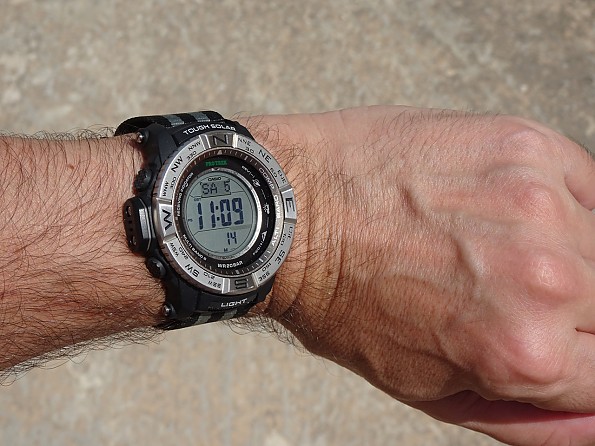
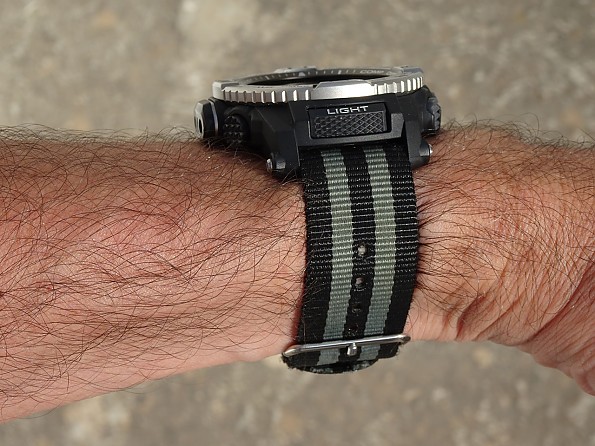
If you set the PRW3500 and the PRG-270 side by side, you can see that the digits in the middle of the PRW3500 display are taller, but this watch hardly looks any bigger overall.
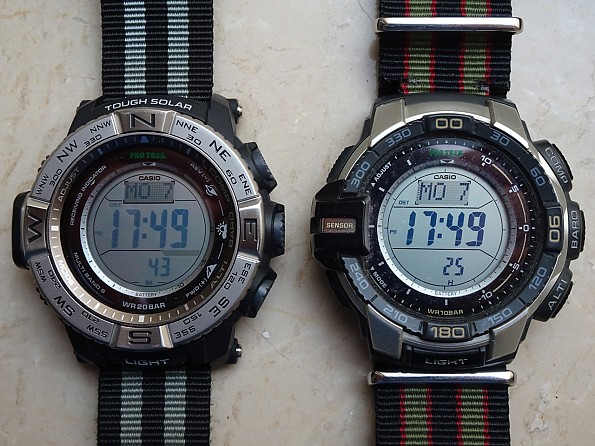
The basic altimeter, barometer and compass functions of the PRW3500, like those of the PRG270, are activated by dedicated buttons on the right side of the watch case. The resin case of the PRW3500 is moulded to form a rim around the lower half of each button. This is intended to prevent you pressing the buttons inadvertently when you flex your wrist. I have never had such a problem with the PRG270, but perhaps this is an issue for people with chunkier hands.
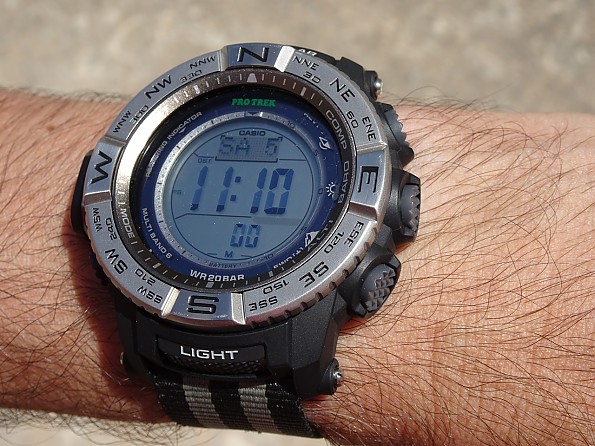
There have been PRW3500 variants in different colours, but most of them are no longer available. On the PRW3500-1 the rotating stainless steel bezel is unpainted and in a matt finish, except for the raised segments which are shiny. The bezel gives the 3500-1 a touch of class and makes it look less plasticky. This model is the best looking digital watch in the Pro Trek range, and the most presentable in an indoor setting (well, in my opinion at least).
The bezel has a practical use as a means to remember the bearing you have to follow if you are navigating by the watch compass. Aim the watch so the 12 o’clock position points in the direction you want to go, then rotate the bezel to align north on the bezel with north on the display. The bezel has just the right amount of resistance: it turns easily, but not so easily that it will turn on its own from contact with your sleeve. The raised segments on the bezel give you added grip when turning it with gloves on.
Strictly speaking, the bezel is redundant because the watch compass has a bearing memory function that displays both your desired and actual bearing (the PRG270 also has this function). However, I find the bezel simpler and easier to use.

The watch compass sensor is accurate to within ten degrees, so you may need a more accurate compass if you need to follow a precise bearing. Often, however, an approximate bearing is enough. It has been so on all occasions when I needed a compass bearing, including my Welsh bog-hopping episode.
The PRW3500 can calibrate its time-keeping to the second using radio signals transmitted from stations in England, Germany, China, Japan and the US, if they are in range. The US station is at Fort Collins, Colorado. This feature is often called atomic time since the transmitting stations keep time using atomic clocks. However, Malta where I live is just beyond the transmitting range of the nearest station, which is the one in Germany. Out of curiosity I have tried the radio calibration function anyway, but with no success.
The PRW3500 should keep time accurately even without radio calibration if the PRG270 is anything to go by. I last set the time on my PRG270 years ago (both models have a DST on-off feature and world time, so you don’t need to reset the time for summer or winter or if you travel), yet it has gone off track by no more than twenty seconds over all this period.
The PRW3500 is water-resistant to 200 metres compared to 100 for the PRG270, but this is not important to me because I do not intend to use the PRW3500 for swimming or other water sports. On a couple of occasions I kept my PRG270 on while taking a shower, and this is as far as my PRW3500 is ever likely to be in contact with water.
Casio seems to be gradually phasing out the digital watches in its Pro Trek range in favour of analogue models. Its most recent models are battery-powered because they come with smart features that are too energy-hungry for solar power. This might make solar-powered digital hiking watches like the PRW3500 a thing of the past, which would be a pity. Such watches display ABC information much more clearly than analogue models and they thrive on neglect, unlike smart watches. I have had my eye on the PRW3500 as an eventual replacement for my PRG270, so I decided to get it now while it is still available.
Update, November 2020
My PRW3500 was delivered with a medium power reading (that's the little "M" at the bottom of the display, as shown in the photos above). I did not bother leaving it out in the sun to get a full charge as I had done with my PRG270. Instead I simply wore it on a few long walks. Swinging a walking pole in my watch hand as I normally do helped keep the watch exposed to the sky, and this was enough to bring the charge indicator up to high. There it has stayed ever since, even with regular indoor use.
I have forced myself to use some of the harder-to-access features of the watch, such as the stopwatch and timer—something I never really did with the PRG270. As a result the user interface started to make sense and I can now access these features through a mixture of recall and trial and error.
I continue to be very pleased with this watch. Here's hoping for the defeat of COVID and a return to something like normality so I can put this watch to use on fresh adventures abroad. In the meantime, here are some extra photos. The first and third photos show the watch in its proper element, while the second illustrates what I meant when I said it is presentable even in an indoor setting.
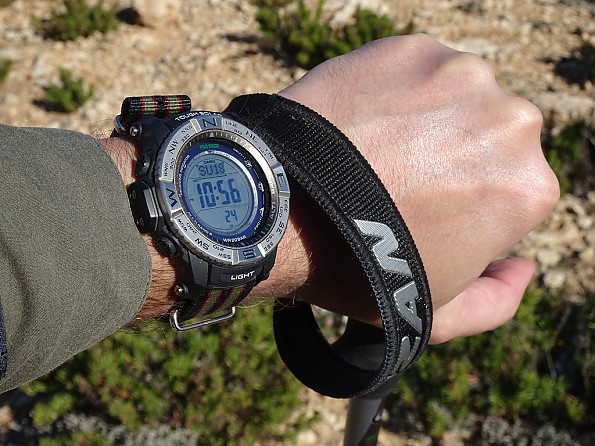

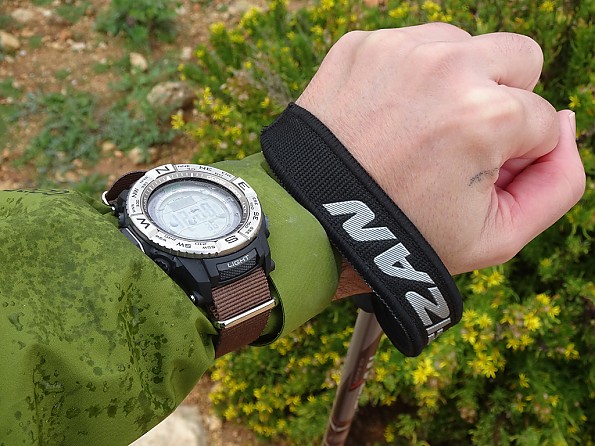
Background
I have acquired this watch only recently, but I have used a different model with similar features for four and a half years.
Source: bought it new
Price Paid: $224
Brilliantly designed and rugged watch with altimeter-barometer-compass functionality. Great for backcountry, fine for EDC. An excellent option for those looking for this feature set.
Pros
- Superb design
- Dual screens
- Useful ABC options
- Solar recharging
- Nightly atomic clock synchronization
- Cool auto-light feature
- Comfortable and secure
Cons
- Huge and heavy on the wrist
- Sensors are not supremely accurate
- Sensors require recalibration
- Somewhat quiet alarm (could be good for light sleepers)
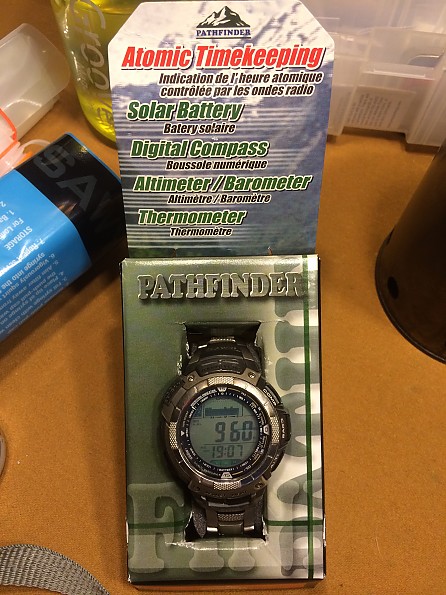
I purchased this Casio Pathfinder watch several years ago after much Internet research. I knew I wanted altimeter-barometer-compass (ABC) capabilities, and I was drawn to the titanium for its durability (okay, and cool looks).
Three other features appealed to me as well--a cool light function (more on this later), the solar recharging ability, and the nightly synchronizing of the watch with the nearest atomic clock. Here was a watch that illuminated itself when turned toward my face for reading it, whose battery wouldn't die, and that would always have the correct time!
It is a sizable beast, but I find something satisfying about that: it measures 53mm from left to right across the watch face, and it weighs in at 111g/3.88 oz. The massive watch is secured by way of an adjustable titanium watch band with a double clasp for extra security.
As you can see (image, above), the watch completely spans my wrist. In the image below, you can get a sense of its high profile. I've never had it snag on something, but I suppose that is something to think about depending on what sort of activities you plan to wear it during.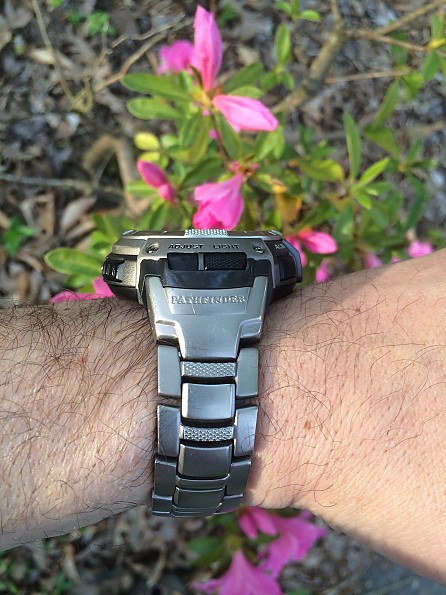
Note: What follows is an overview of watch functions and features. If you wish to skip over this, scroll down the the section labeled Reflections, below.
Watch Functions and Features
While the owner's manual is unquestionably daunting (a 3/4-inch thick block of thin paper in multiple languages), one can master the basics of the watch's functions in little time. The usual display (what Casio terms Timekeeping Mode) indicates either the day, and time (in hours, minutes, or seconds) or the date and time (see below, set to date mode). Time can be shown in either 12-hour or 24-hour display; a P indicator appears during PM hours of the 12-hour mode.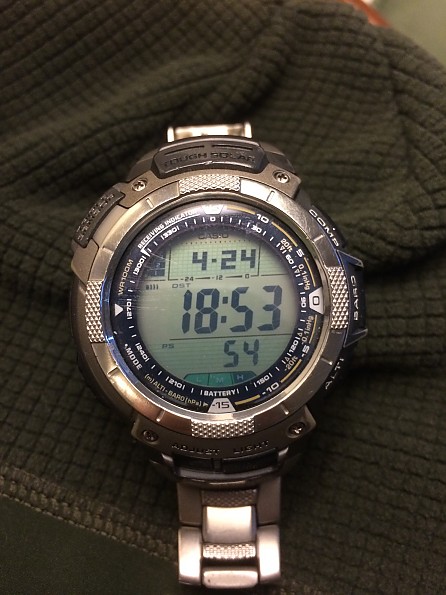
Additional icons indicate the strength of the radio reception indicator for the atomic clock (black bars in upper left), a battery strength indicator (L, M, and H across bottom of display), whether or not the watch is on Daylight Savings Time (DST indicator above hour), and a Power Save mode indicator (PS in lower left). The DST mode activates automatically if you wish, synching via the nearest atomic clock to ensure year-round timekeeping accuracy. The Power Save mode allows the watch to go to sleep when it is in the dark for 60-70 minutes (at night, for instance). This is a huge key to the watch's efficient operation.
The watch hides some nice features, one of which is the black border above the display. This is actually a solar cell that recharges the battery. I keep the watch in Power Save Mode, and in the years I have had the watch, the solar recharging and Power Save mode have meant that I have never had to purchase a new battery. I don't think the charge indicator has every moved from the H (high charge setting), an indication of the efficiency of the watch's operation in Power Save Mode. I love this feature because it means I can count on my watch.
A mode-select button is located in the bottom left of the watch (just to the left of the lefthand screw in the image below). Depressing this button cycles the watch through its various screens.
The first mode after Timekeeping Mode is Data Recall Mode (see image, below). This mode allows one to view altitude periodic records currently in the watch's memory. No record is indicated on the screen in the image.
Another push of the mode-select button takes you to the World Time Mode. This is useful for world travelers, allowing one to keep one's home time on the Timekeeping screen while selecting one of 29 provided international time zones on this screen. I have used this abroad several times and found it quite convenient (I just use the WTM screen as my home screen until I return home). The watch is set to New York time in the image below. And yes, the Daylight Savings Time feature works in World Time Mode, too.
Yet another push takes you to the Stopwatch Mode (image, below). The display gives you hours, minutes, seconds, and 1/100ths of a second. A nice feature here is that the display also shows the Timekeeping Mode at the bottom while the stopwatch is operating. Functions in this mode include elapsed time, split time, and the recording of two finish times.
The next screen accessed via the mode-select button is the Countdown Mode. Here you have a 1-60 minute countdown timer that triggers an alarm upon reaching zero. An auto-repeat mode is available if desired. I have the timer set for 25 minutes in the image below. Progress beepers may be set to go off at minute 10, 5, 4, 3, 2, and 1 or at seconds 50, 40, 30, 20, 10, 5, 4, 3, 2, and 1 in the final minute of the countdown.
Naturally, the watch has an Alarm Mode, too--five alarms per day if you wish, plus an hourly signal for the time-conscious folks. When I first got this watch, I found the alarm to be remarkably soft in tone; I was worried I would sleep through it. Well, I have sometimes, generally when my wrist has been under a pillow, but for the most part I find the pitch of the tone sufficient to awaken me. After a while, the sound becomes familiar, a sign that it is time to get up. My worries have long since abated, but this is a consideration for sound sleepers (I am a light sleeper).
The final mode in this circuit is the Receive Mode (image below), which indicates when the watch last received a signal from the nearest atomic clock to synchronize the time. I have mine set to do this nightly. The display below indicates that my watch last synched with the attic clock at 12:05 AM (0:05 24-hour mode) on April 24. If interference prevents radio reception, the watch allows you to manually initiate the synchronization process.
On the bottom bezel of the watch is an Adjust button (think Set button, but with more uses due to the watch's complexity) and a Light button. Both are protected to prevent inadvertent pressing. The light function is very cool: depress the button and the electro-luminescent panel glows blue-green; hold the button for a few seconds and the Auto Electro-luminescent mode turns on. In this mode, a turn on the wrist that raises the watch parallel to the ground and then to an angle more than 40˚ will activate the light. Yes, that means hands-free operation.
The geek factor of this feature is wonderfully high, and I have found it useful under certain circumstances. If I am hiking at night and wish to monitor my progress, this feature works brilliantly (get it? sorry . . . ). However, I have also forgotten to turn the A.EL mode off again, and found myself coming fully awake in the night as I accidentally activate the light while turning in my bed. Driving with this mode on is not a good idea at night: the sudden flash of light as you turn the steering wheel can cause momentary night blindness (no, it isn't that bright; just that stunning coming from the usually dark space).
This mode gets the most questions from friends when I casually "happen" to demonstrate it. No buyer's regret for this feature! The light is hard to photograph; my apologies for the blurry, poor quality image below. The actual light does not bleach out the numbers; my camera just couldn't figure out how to focus on something that was lit for 2.5 seconds at a time. The color, however, is true. Hopefully you can get the idea.
The Altimeter-Barometer-Compass functions feature separate buttons on the right side of the watch casing, Compass, Barometer, and Altimeter respectively from top to bottom.
The Digital Compass adds obvious functionality to the watch but also some cool factor, too--a floating display is suspended above the regular Timekeeping display, allowing blue compass indicators to appear above the black readout of the degrees (see image below).
North, south, east, and west are indicated by the blue directional markings with north being indicated by the thicker triple indicator (at bottom of watch in image); the 12 o'clock watch position is the direction that the watch reads, in this case, 183˚ S, or south. Casio indicates a margin of error at +/- 11 degrees. The watch display includes 16 direction abbreviations--N, E, S, W, NNE, ESE, SSW, WNW, NE, SE, SW, NW, ENE, SSE, WSW, and NNW.
The Barometer is actually a Barometer/Thermometer (see image below). These functions utilize a pressure sensor (barometer) and a temperature sensor. A nice feature here is the graph of elapsed barometric data at the top of the screen. The blue overlay indicator here suggests the trend in air pressure--rising (indicator pointing up), holding steady (indicator at 3 o'clock), or falling (indicator pointing down).
In the image below, the pressure reads 983 hectopascals (1 hPa= 1 mb). The graph shows approximately the last 30 hours of barometric readings (taken every two hours), a useful feature for identifying weather trends. The blue indictor line indicates a rising pressure trend, the differential between the current reading and the historical data depicted in the graph. I just removed the watch from my wrist, so the 83.2˚F reading is not accurate; it is inflated due to my body heat. Removing the watch for about 30 minutes allows (I hang it up at night when camping) allows accurate air temperature readings.
The Altimeter works from a barometric pressure sensor that takes the reading and then estimates the altitude based on "International Standard Atmosphere preset values." Sorry, folks; that's straight from the manual--I can't elaborate. The most accurate reading comes with using a reference altitude: find yourself on a topo map and init the altitude reading into the watch. A number of variables impact the altimeter, including temperature: Casio warns not to use this for sky diving, hang gliding, paragliding, etc.
For all that it may not be the most accurate, the altimeter is a useful tool. Zeroing it at the base of a building allows one to determine the buildings height when you reach the top; taking a reference altitude does the same thing for measuring elevation gain or loss in the mountains. The savvy backcountry traveler knows that an altitude reading--coupled with accurate interpretation of local geography and reading of a topi map--can help one locate one's position on a map.
The altimeter also records data over time, graphing it for quick reference, and allowing one to toggle through high and low altitude data, total ascent or descent, and relative altitude change data. My reading in the image below is 960 feet above sea level with the blue indicator arrow and the graph showing that I have not gain or lost altitude, which makes sense since I was standing in my living room. Elevation interval are recorded in 5m/20 foot increments, from -700 to 10, 000 meters/-2300 to 32, 800 feet.
Reflections
While it took me a few days to get used to the mass of the Pathfinder, I have always found it to be comfortable. Surprisingly so: I didn't think the titanium band would be all that comfortable, but the watch back is contoured to sit securely on the wrist, and the band offer multiple means of adjustment to ensure a comfortable and secure fit. That said, the weight of this watch will not make it attractive to some, nor will its massive size endear it to those with small wrists. And heavy sleepers, don't forget my caution about the alarm being softer than some watches' alarms.
I've lost track of how many years I've had this watch now. I wear it constantly, even (perhaps foolishly) in the shower for years on end before I relented and cleaned it (hello, soap scum). It has been in lakes and creeks and oceans, in hot summer sun and bitter winter cold. It has had its share of blows and dings and dust and dirt--aside from some silver-tone paint wearing off and an indentation in the Adjust button--it shows no signs of damage or wear. Construction quality is excellent, durability is superb. Sensors do need to be recalibrated from time to time, of course. At present I seem to have a glitch in my compass that causes some inaccurate readings; I plan to have it serviced soon to address this (I'll attach an addendum to this review should the service results merit it).
The accuracy of the sensors is basically ballpark--I mentioned the +/- 11 degrees accuracy of the compass; the thermometer seems to be accurate within a few degrees when off the wrist, and the altimeter seems to work best when a reference elevation is used. I wasn't seeking professional accuracy from these ABC functions, but rather a quick confirmation of direction of travel, the morning air temp when I rise in camp, and a general sense of elevation loss of gain over time. It is fine for these sorts of uses. The graph of barometric data is very useful, and several times the barometer has saved me from getting soaked by an approaching front. That's all I am really asking for from these functions.
Obviously, this digital compass can't compete with a quality hand-held compass for backcountry navigation, nor can the altimeter compete with a stand-alone, professional altimeter--those seeking such accuracy should look elsewhere. But the fact that these functions coexist with a highly functional watch replete with solar recharging, auto-lit display, and atomic timekeeping makes this a very useful set of tools in one satisfyingly heavy package. I love having the capabilities strapped to my wrist on a day-to-day basis. I enjoy the ease of use.
This isn't a piece of gear that stays closeted: I use the alarms daily, and often I find myself checking the barometric pressure--that gets addictive, especially as clouds roll in. The price may be a deterrent for some (though it is cheaper now than when I got mine). I made the conscious decision to go this route with a watch because I wanted the multiple capabilities in a single device and I wanted the solar option--I've had too many digital watches die at inopportune times.
Stretched over the years I've had the watch, the original sticker shock seems to me now more like a good investment. I recommend this for hikers, campers, and backpackers who are seeking reasonable accuracy in a single device equipped with ABC functionality. And besides, the Auto Electro-luminescent feature will wow your pals around the campfire!
Source: bought it new
Price Paid: $250
This review is for the Casio Pathfinder PAW1300T-7V. This is the titanium slimline version of Casio's Pathfinder watches. This is a fantastic looking timepiece. The smaller size and lower profile eliminates the "geek" look, common of most multifuction watches.
Since the watch updates the time from the radio transmitter in Fort Collins at midnight every night, its accuracy is never in question. The manual suggests that you remove the watch and place it on the window sill for accurate updates, but I wear the watch to bed and have never had a problem receiving the update - even when in the backcountry.
Compass, Altimeter, Barometer, and Thermometer all work great. As with most watches like this, you have to remove the watch to get an accurate temperature reading. The compass takes some getting used to because it only takes readings for 15 seconds after being activated in order to save the battery. You can keep pushing the compass button if you need more 15 second intervals to get your bearing.
As far as the battery goes, the watch is solar powered and charges the battery during the day. The battery level indicator on mine has never moved off of full charge even with repeated backlight usage. (The watch is supposed to last 5 months without a recharge.)
The only reason I didn't give this watch a 5.0 was because of the backlight. On the slimline version, the light comes on for two seconds max with each push of the button. (You can make the watch illuminate by turning your wrist also.) Two seconds isn't much time to take a bearing if you are using the compass at night. (Of course you shouldn't be navigating at night without a flashlight.) Some of the other versions of this watch have selectable backlight time.
The display is large, clear, easy to read, and customizable. The titanium version is extremely rugged and great looking. In my opinion, it's the best backcountry watch you can buy at any price.
Price Paid: $320
I owned G-Shock watches prior to buying the Pathfinder PAW1500. I was very happy with them but wanted some of the features of the Pathfinder series. The PAW1500 seemed to have the best of both worlds plus compass, solar rechargeable, and Atomic time setting.
Number one: it keeps perfect time day in and day out despite the abuses of being hit and banged, or going straight from the sunlight on a 95=degree day into a cold stream of water. I use the tidal and moon phase data to help me make fishing decisions similiar to; well it's time to go home.
The back light is clear and bright, however I wish it stayed on a few seconds longer instead of the 2 to 3 seconds at a time. The auto light feature turning on by itself when you twist your wrist is very convenient because it allows you to read your watch in the dark without having to use your other hand.
On a scouting trip in the woods I sunk my truck in a ditch and was not precisely sure exactly where I was, and with a solid overcast I could not see the sun. I did know that I could go cross country thru the woods due west and eventually intercept an access road. Punched the watch compass button once and within seconds I started moving west and kept doing so until reaching the access road. The watch immediately gave me the confidence that I would be coming out of the woods relatively quick instead of wandering in the failing light as evening approached, and I did.
It is very easy and pleasurable to rate the Casio Pathfinder PAW1500 as a superior product.
Price Paid: $125, used from E-bay
I still have one of these (minus the Titanium). Only issue I've had is the band breaking. I replaced the watch with a newer model just this year, but the old one still works fine and looks good.
Pros
- Takes a beating
- Solar keeps it ticking
Cons
- Watch band broke; it's discontinued so finding parts is difficult. But it did take a few years to get to that point.
If you need a sturdy watch that does almost everything you need for basic navigation, this watch will do it. If you find one, try to get a spare band to go with it.
Barometric pressure sensor helps warn you of foul weather. Compass is very visible on the screen. You'll need to take it off to get an accurate temperature reading. Altimeter will probably need to be reset before using it on a planned trip, but once it's calibrated it'll do the job.
If you're looking for a brand new ABC watch, Casio has plenty of newer models with newer tech (I recently picked up a Pro Trek PRW-3400 that'll probably cover me for the next ten years). But, if you see one of these at a flea market or yard sale, and it's still running, it's definitely a deal worth picking up.
Background
About 10 years.
Source: bought it new
Price Paid: $150
I bought this watch a little over a month ago, and so far, it has lived up to its billing. I purchased it primarily for the altimeter, but I find myself using its other functions quite often.
I typically wear it hiking or mountain biking, and track my time with the stop watch function. Before hitting the trail, you have to calibrate the altimeter to ensure that it works properly. Some find this annoying, but you will have to do this with any barometric altimeter and it takes less than a minute once you have the hang of it. The altimeter tracks in 20 ft. intervals, which is fine for my purposes.
The barometer takes readings every two hours and has kept me aware of impending weather. Twice now I have been out with questionable weather and both times the barometer gave me accurate information to make a quality decision in whether to head back to the car or trek on. Also, a thermometer will track outside temperature, but you have to take it off your wrist for it to be accurate, as it will measure your skin temperature if it is on your wrist.
I have not really used the compass feature, but I tried testing it on the trail and it seems to work fairly well.
Two advantages of this watch (compared to the Casio Pathfinder PAG40-3V) are its solar power feature and atomic timekeeping. I never have to worry about setting the time, and my battery is always fresh. The solar power feature is huge, because if you are using the many functions that the watch has, you will drain the battery that much quicker. With the solar power, as long as the face of the watch gets light (natural or otherwise) it will operate just fine.
When I was doing some research and price checking, I found it listed for almost $100 cheaper online than in retail stores, but I picked mine up from REI anyway as they have a quality return policy and great customer service. So far, all of my hikes and mountain bike rides have been day trips, but I have confidence this watch will do just fine with extended trips as well.
Price Paid: $269
So far I am very pleased with this watch. I love all the features it has.
The compass works good, it is not accurate enough for map work but it will keep you going in the right direction. The recessed watch face is good and with the stainless steel bezel around it, the potential for scratches or scrapes on the watch face are minimized. It is definitely water proof as I found out and all watch functions perform as advertised.
Calibrating the compass and altimeter are time intensive and the operation of the altimeter takes getting used to so be sure and get familiar with the watch before you take it backcountry.
The weak point of this watch seems to be the resin band. It appears a little on the weak side and the buckle seem a little cheesy, but I have yet to have issue with it.
I am pleased with the watch.
Price Paid: $150
Received a PAG 80 as a gift that I've wanted in 2008, it was about $100 at the time.
Pros
- It still works.
- So many specs to mention
- Waterproof
Cons
- Can't find parts for watchband
- Have not learned yet all of the options...
- Must make adjustments to ALT and Barometer to get Compass direction
It is a great watch to have with you.
But, you must make adjustments to the ALTIMETER and Barometer to get correct Compass direction.
The only issue I have after so many years is the band. The little eye broke and the band gets in the way...
Source: received it as a personal gift
I've used this on several backpacking trips. Keeps time real good, alarm works well, compass works great, barometer works pretty good, however temp function does not work with the watch on your arm, also the altimeter not always accurate.
This may not work for everyone but for me it worked pretty good. The watch does take awhile to get use to. The Casio Pathfinder PAG40-3V is rather large and takes time to adjust to wearing it.
Price Paid: $130
I have the Casio Pathfinder 3070 1300-T (Titanium bracelet) and it's as tough as nails.
Cons
- The Atomic time set doesn't work every night
- Can't hear the chime
I just got this cause I needed durability and waterproofness.
Background
When camping the atomic time set even works when it's in the tent.
Source: bought it new
Price Paid: 250$ CDN
Your Review
You May Like
Specs
| Price |
Historic Range: $124.98-$400.00 Reviewers Paid: $125.00-$320.00 |



